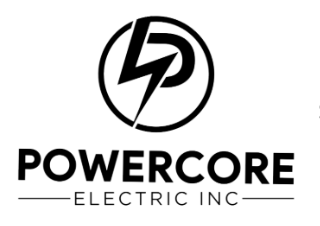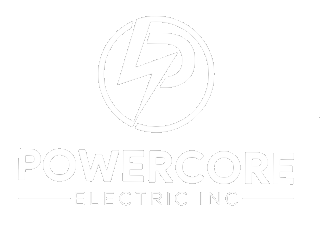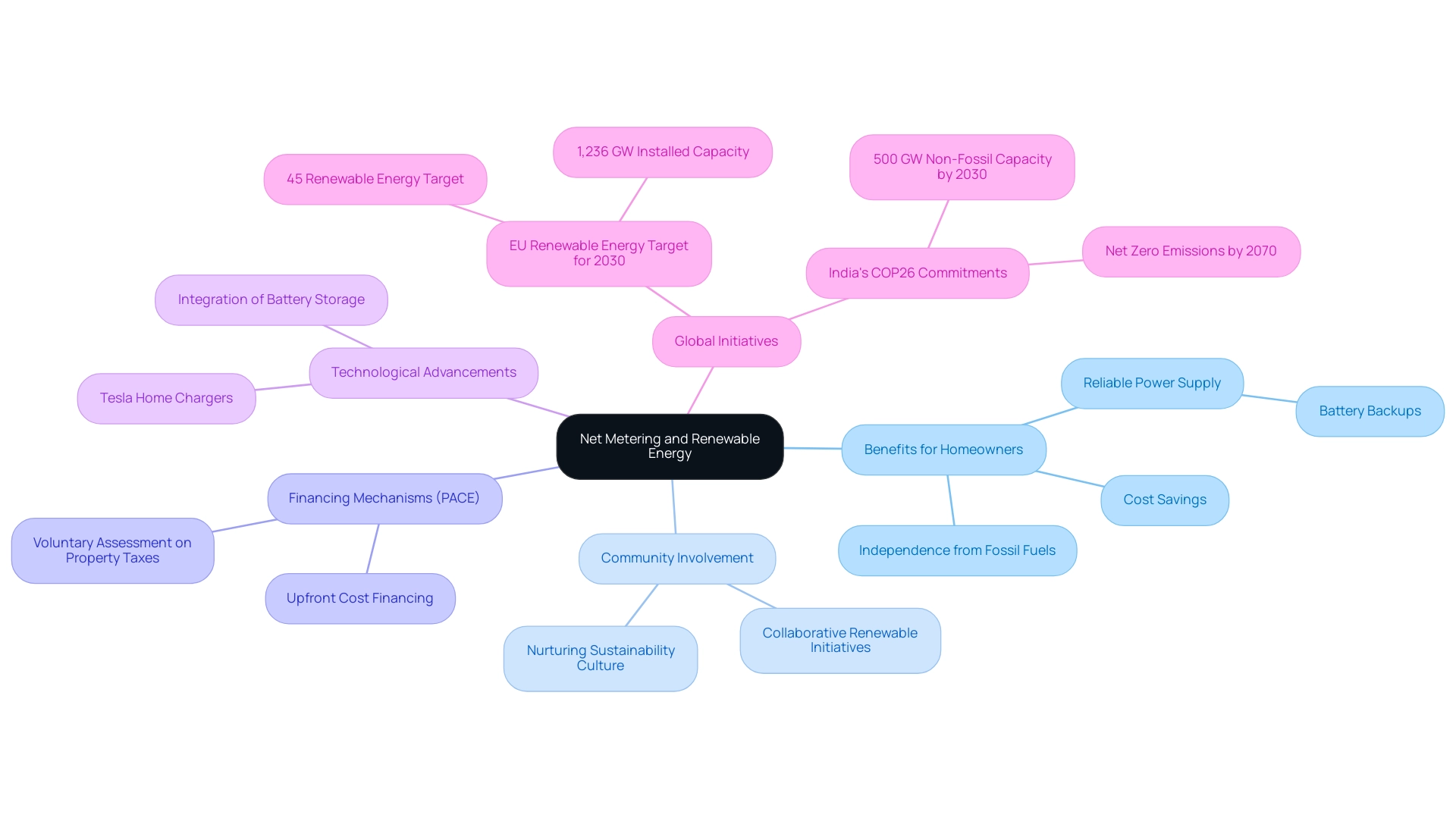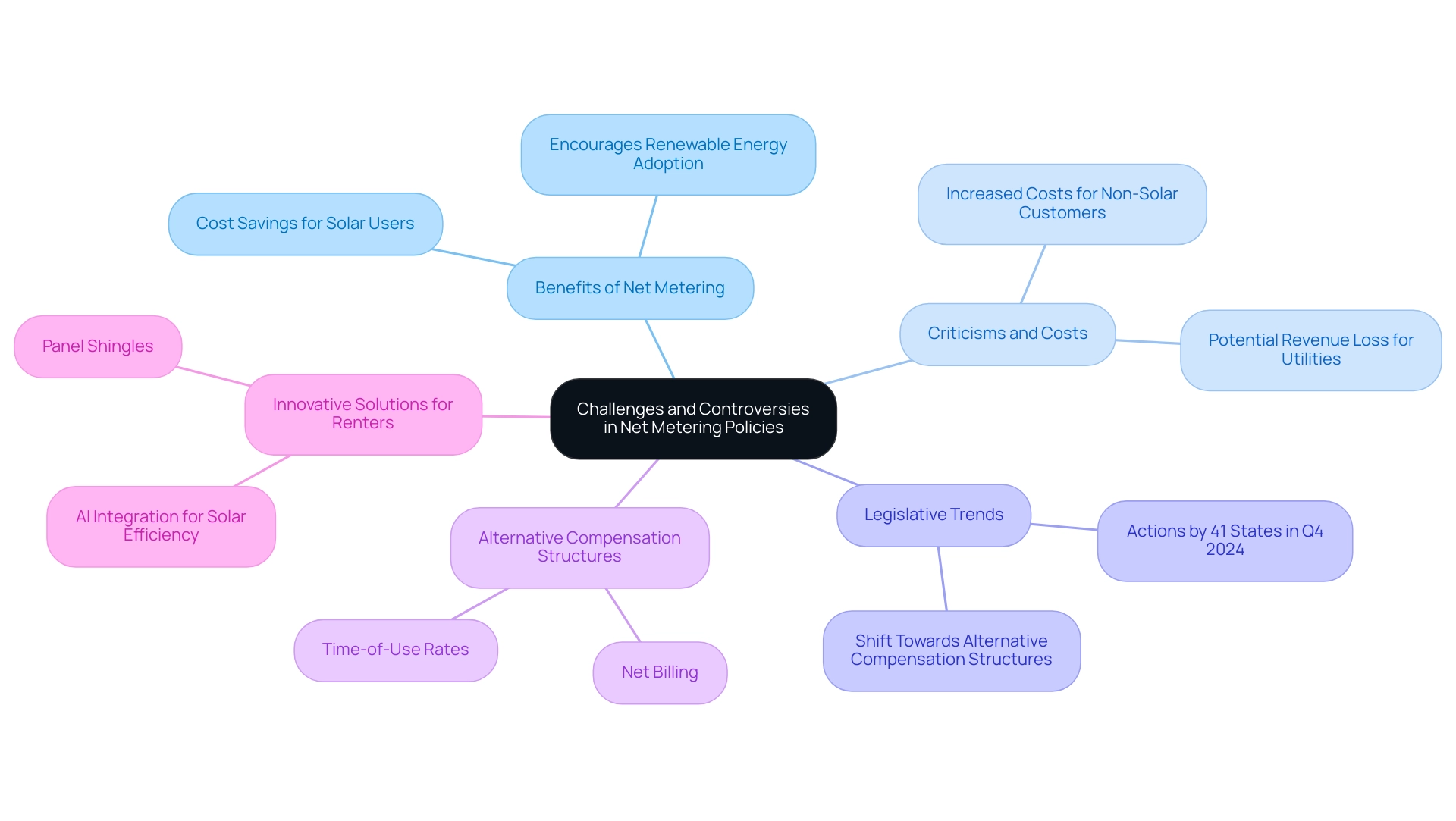Overview
Net metering for solar panels is a billing arrangement that allows homeowners to earn credits for the surplus electricity generated by their solar systems, which they feed back into the grid, ultimately reducing their electricity costs and promoting renewable energy adoption. The article highlights that this system not only offers significant financial benefits, potentially saving homeowners thousands over time, but also fosters community involvement in sustainable practices and enhances grid stability by reducing peak demand.
Introduction
As the sun rises on a new era of energy consumption, homeowners are increasingly turning to solar power as a sustainable solution for their electricity needs. At the heart of this transition lies net metering, a game-changing policy that allows solar panel owners to earn credits for the excess energy they produce and feed back into the grid. This innovative billing arrangement not only makes solar energy more financially viable but also plays a crucial role in promoting renewable energy adoption across communities.
With a growing number of states embracing net metering policies, the potential for significant savings and increased property values is enticing for eco-conscious homeowners. However, as this landscape evolves, it’s essential to navigate the complexities and controversies surrounding net metering to fully understand its implications for the future of energy.
This article delves into the ins and outs of net metering, exploring its benefits, challenges, and the exciting trends shaping its future.
Understanding Net Metering: Definition and Functionality
Understanding what is net metering solar panels, we see it as an innovative billing arrangement that empowers eco-conscious homeowners with photovoltaic panels to earn credits for the surplus electricity they generate and contribute back to the grid. When your photovoltaic system generates more power than your home uses, that surplus is directed to the utility grid, which exemplifies what is net metering solar panels, resulting in credits on your utility bill. This arrangement not only makes transitioning to renewable power more financially attractive but also encourages the broader acceptance of sustainable resources, particularly in regions like California where construction regulations and NEM 3.0 propel initiatives related to solar power.
What is net metering solar panels? It enables homeowners to effectively ‘bank’ their excess energy, helping to offset future energy costs and creating a win-win scenario for both the homeowner and the environment. In fact, as Craig Kaiser highlights,
According to predictions from SEIA, the nation’s cumulative renewable energy capacity will be sufficient to power over 71 million homes by 2029.
With the current total energy capacity in the U.S. standing at an impressive 219.8 GW and a thriving market valued at $63.6 billion, it’s essential to know what is net metering solar panels as it plays a crucial role in this rapid growth.
Notably, a new renewable energy project is installed every 39 seconds in 2023, highlighting the rapid expansion of this energy source and raising the question of what is net metering solar panels. Solar panels work by converting sunlight into electricity through photovoltaic cells, which generate direct current (DC) power that is then converted into alternating current (AC) power for use in homes. Furthermore, government initiatives for renewable energy, such as tax credits and rebates, further encourage property owners to embrace this technology, making it more attainable and economical.
For those interested in exploring solar options, Land App offers a valuable service for locating active, building, and planned solar farms in the United States for just $10/month.
Economic Benefits of Net Metering for Solar Panel Owners
Homeowners often wonder what is net metering solar panels, as it offers one of the most compelling economic advantages: a noticeable reduction in electricity bills. Imagine cutting your power expenses, particularly during peak hours when electricity prices soar! Homeowners with energy systems that produce more power than they consume can benefit from bill credits that carry over into future billing cycles, effectively reducing their overall energy costs.
Depending on your area’s electricity costs, you could save between $28,000 and $120,000 over the lifetime of your panel system, as noted by Emily Walker. Beyond just savings on monthly bills, understanding what is net metering solar panels can also boost your home’s market value. Homes fitted with photovoltaic panels are generally more attractive to purchasers, frequently selling at a premium—on average, homes with existing energy systems are valued about 4.1% higher than those lacking.
This is mainly due to potential property owners valuing the long-term savings and environmentally friendly advantages that renewable power offers. As Rosana Francescato, a seasoned expert in clean power communications, emphasizes, grasping these financial incentives makes photovoltaic power not just a sustainable option but a smart investment for property owners seeking to enhance their property’s value and lower their utility expenses. Furthermore, with 34 states and Washington, D.C. having mandatory policies, understanding what is net metering solar panels highlights the increasingly favorable implications for residents across different regions.
For individuals in Long Beach, it’s crucial to investigate how these advantages relate to residential panel sizes and the 200% Rule, which permits residents to set up systems that can produce up to 200% of their power requirements. This maximizes potential savings and aligns with the case studies demonstrating how property owners have successfully utilized energy systems under this rule to achieve significant financial and environmental benefits.
The Role of Net Metering in Promoting Renewable Energy and Grid Stability
What is net metering solar panels and how do they serve as a revolutionary factor in encouraging renewable power sources, especially sunlight-driven? By providing incentives for property owners to install solar panels, we can understand what is net metering solar panels, which greatly enhances clean power generation throughout communities. This shift not only helps reduce utility costs, allowing you to save money, but also enhances independence by lessening our reliance on fossil fuels and promoting a sustainable lifestyle.
As more homeowners generate their own electricity, it reduces the demand on the grid during peak times, resulting in fewer outages and a more resilient power system overall. Moreover, net metering encourages community involvement in renewable initiatives, nurturing a culture of sustainability and environmental responsibility among neighbors. A notable example is the Property Assessed Clean Energy (PACE) programs, which allow property owners to finance the upfront costs of energy installations through a voluntary assessment on their annual property taxes.
This innovative financing mechanism has made photovoltaic power more accessible, promoting wider adoption of renewable solutions.
An important aspect of photovoltaic systems is the integration of battery backups, which ensure reliable supply during power outages and adverse weather conditions. This additional level of protection is vital for property owners seeking to uphold autonomy in their power usage. Furthermore, recent progress in solar technology, like Tesla Home Chargers, is simplifying the process for residents to charge electric vehicles with solar power, further encouraging sustainability.
As we approach 2024, it is essential to understand what is net metering solar panels and its growing significance in renewable power adoption. During COP26 in November 2021, India set ambitious targets for renewable power generation, aiming for a 50% share in its electricity mix—more than double its 2020 levels. This commitment emphasizes the growing importance of understanding what is net metering solar panels in enhancing grid stability and building a cleaner, more sustainable future for homeowners.
Furthermore, with the EU suggesting a rise in its renewable resources target for 2030 to 45%, there’s a clear global shift towards sustainable sources. Such advancements highlight the economic and environmental advantages of heating systems, particularly when combined with efficient solutions and battery storage for dependable power during outages. Now is the time for property owners to embrace these solutions and take the first step towards a more sustainable lifestyle.
Challenges and Controversies in Net Metering Policies
While net metering provides considerable benefits for users of renewable resources, it also ignites significant discussion among environmentally conscious homeowners, especially Long Beach renters. Critics often point out that the system can inadvertently raise costs for non-solar customers, as utilities might increase rates to compensate for the revenue lost when customers generate their own electricity. Recent legislative trends in California indicate a shift away from traditional net metering structures; in Q4 2024, 41 states, plus D.C. and Puerto Rico, took action on distributed energy policy or rate design, with 151 actions tracked.
As noted by Autumn Proudlove, managing director of policy and markets at NCCETC, ‘During 2024, we continued to see states move away from traditional net metering and toward alternative compensation structures, like net billing, for distributed generation.’ This change indicates a wider trend to modify how sunlight-derived power is compensated, which could restrict the advantages that panel owners presently enjoy. For Long Beach renters, understanding these dynamics is crucial as they navigate their options for eco-friendly power solutions.
Furthermore, panel shingles provide a creative choice for renters, offering a space-efficient and visually appealing method to capture sunlight without conventional installations. Recent initiatives, including Maryland’s new community program, aim to tackle these issues by enhancing access to renewable resources while also addressing participation in time-of-use rates. Furthermore, the integration of AI technologies is enhancing solar efficiency, allowing for smarter management and optimization of solar systems.
These developments highlight the significance of continuous discussions and policy modifications to ensure that what is net metering solar panels remains a sustainable and fair method for promoting renewable resources. Furthermore, the Public Energy Policy Act of 2019 establishes ambitious goals for attaining 100 percent renewable resources, presently generating 12 percent from renewable sources with an aim of 40 percent by 2025, demonstrating the ongoing changes in net metering policies and their effects on residents in California.
The Future of Net Metering: Trends and Legislative Changes
As sunlight power keeps gaining momentum, understanding what is net metering solar panels is essential, as the future of this system is poised for significant change, presenting thrilling possibilities for environmentally aware residents. Numerous states are presently assessing their power policies to achieve a balance between promoting renewable growth and guaranteeing equitable utility rates for all customers. This evaluation comes at a crucial time, especially with Portland General Electric proposing a rate change that could see reductions of 20% to 30%.
Such changes could lead to a shift away from traditional systems, raising questions about what is net metering solar panels and moving toward more dynamic pricing models that adapt based on usage and generation. Autumn Proudlove, Managing Director of Policy & Markets at NCCETC, noted,
During 2024, we will see states moving away from traditional net metering and toward alternative compensation structures, like net billing, for distributed generation.
Furthermore, dynamic pricing models are emerging as a crucial aspect of new legislation, allowing homeowners to enjoy real-time pricing that reflects market conditions.
Community programs harnessing sunlight are also gaining momentum, allowing neighborhoods to share resources and collectively benefit from renewable power. A prime example is the Maryland Community Energy Program, where the Public Service Commission has made strides to revise the regulations surrounding what is net metering solar panels and implement a permanent community initiative, with interconnection applications opening on January 1, 2025. This program demonstrates what is net metering solar panels and how states are adjusting their policies in response to the increasing demand for renewable power.
For property owners engaged in renewable energy, including those who may gain from the ‘Unlocking Solar Power’ guide for Long Beach renters, keeping informed on these advancements is essential, as they will greatly impact both the financial and operational elements of energy systems in the future. Powercore Electric offers tailored solutions, including solar installations and roof protection, to help homeowners maximize their benefits from these changes while also taking advantage of available solar tax credits and incentives.
Conclusion
Net metering is transforming the way homeowners approach energy consumption, making solar power not just a sustainable choice but also a financially savvy one. By allowing solar panel owners to earn credits for excess electricity fed back into the grid, net metering significantly reduces energy bills and enhances property values. As communities embrace this policy, the momentum towards renewable energy grows stronger, fostering a culture of sustainability and independence from fossil fuels.
However, the landscape of net metering is evolving, bringing both opportunities and challenges. While many states are reforming policies to ensure fair compensation for all energy users, homeowners must stay informed about these changes to maximize their benefits. Innovations like community solar programs and dynamic pricing models are emerging, presenting new avenues for cost savings and collaboration among neighbors.
As the future unfolds, the importance of net metering in promoting renewable energy and enhancing grid stability cannot be overstated. Homeowners are encouraged to engage with these developments, exploring how they can harness the power of solar energy to contribute to a cleaner, more sustainable future. Embracing this shift not only benefits individual households but also strengthens entire communities, paving the way for a greener tomorrow.




